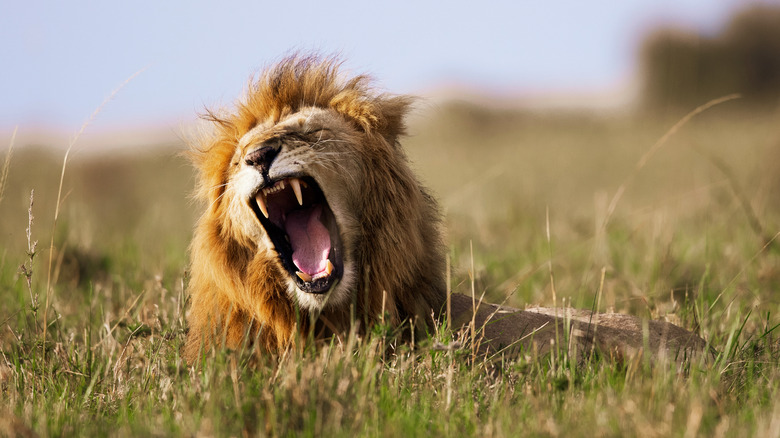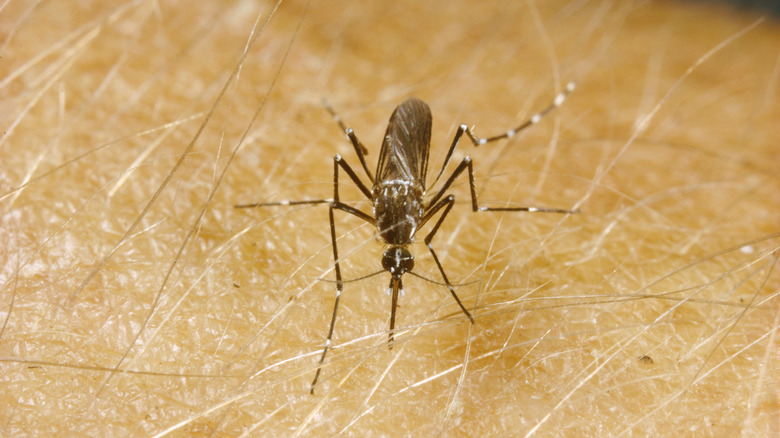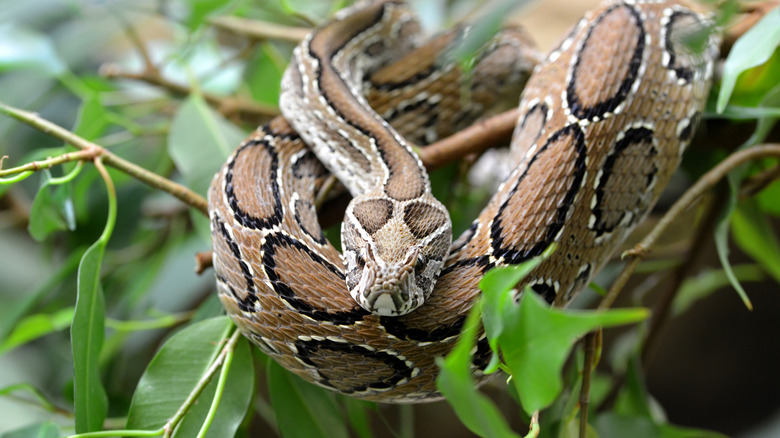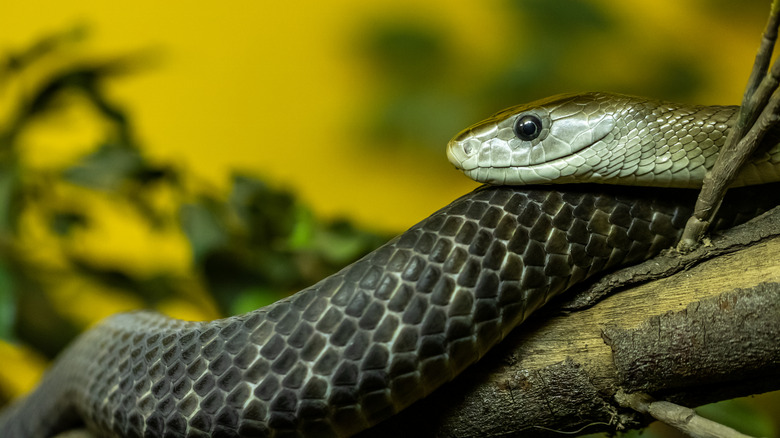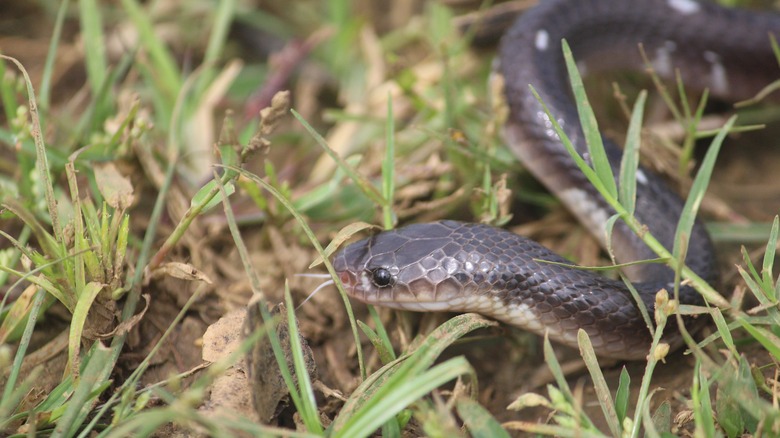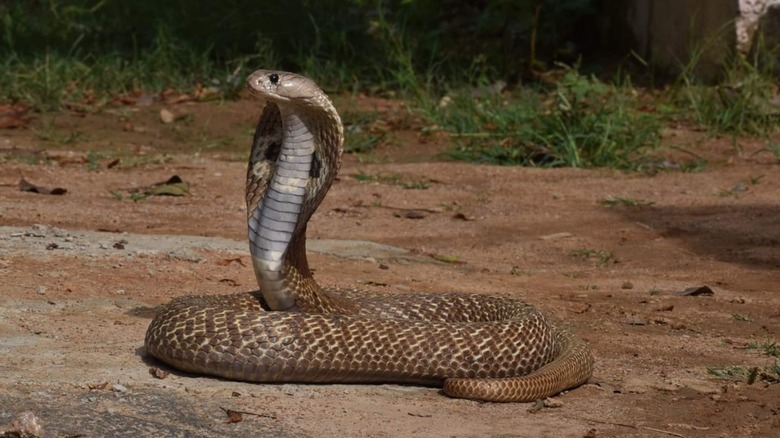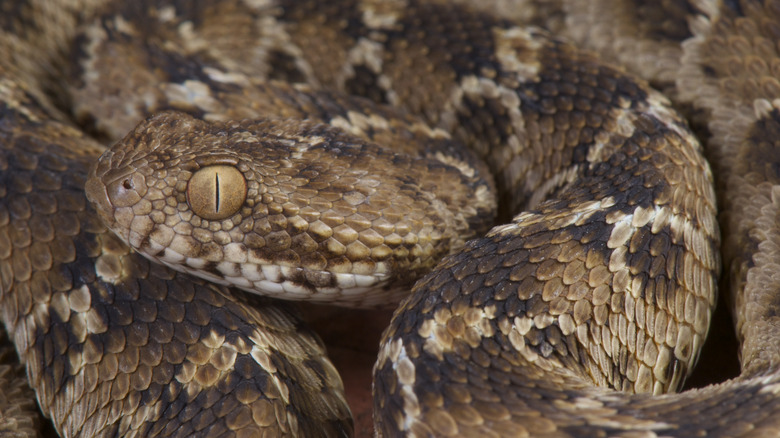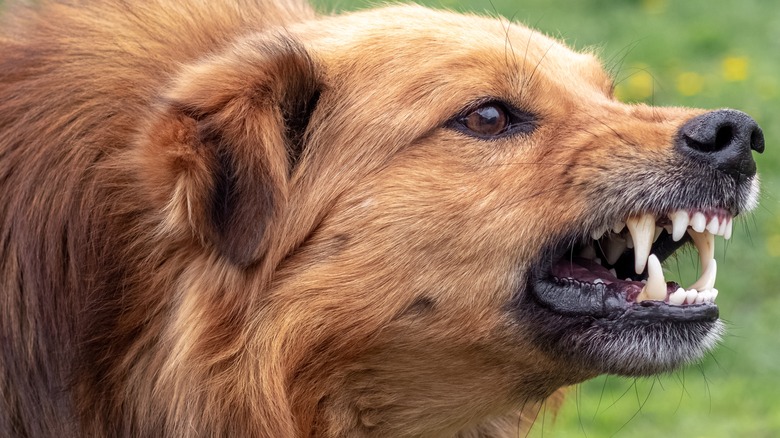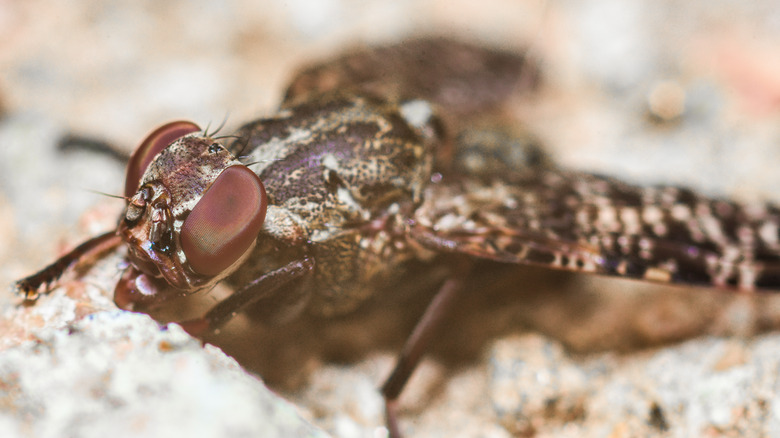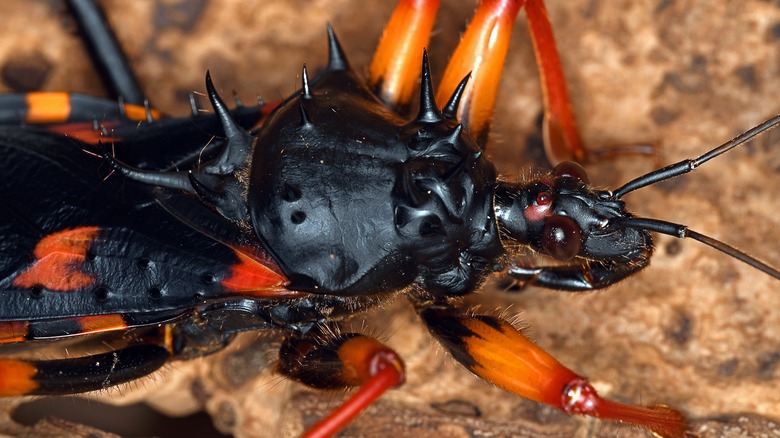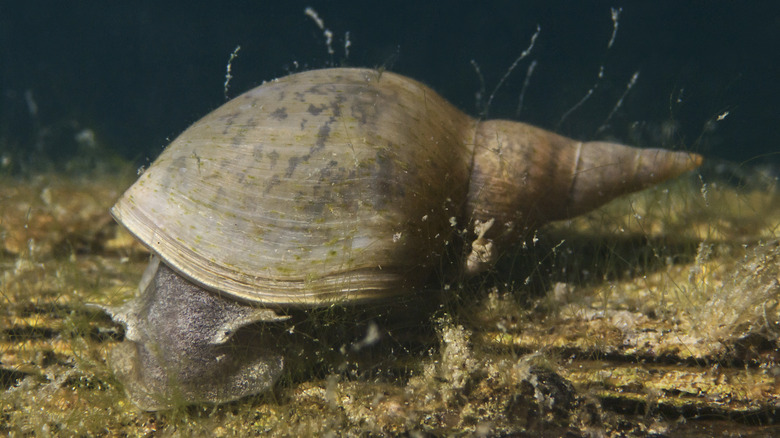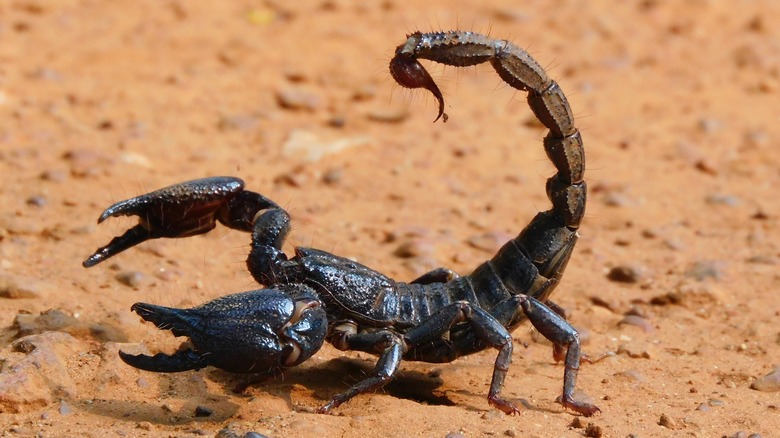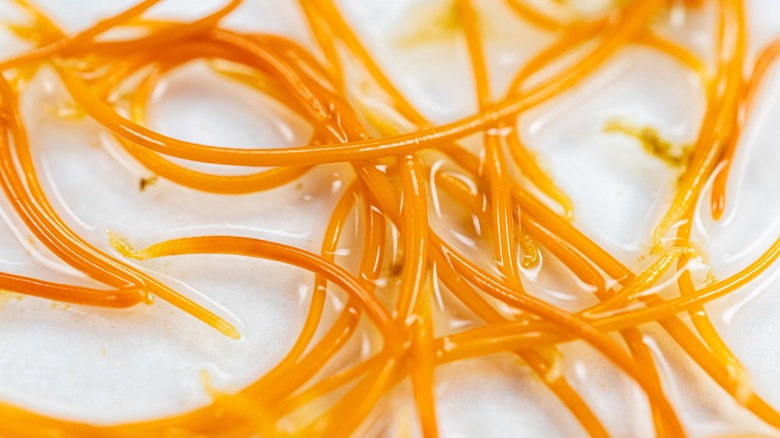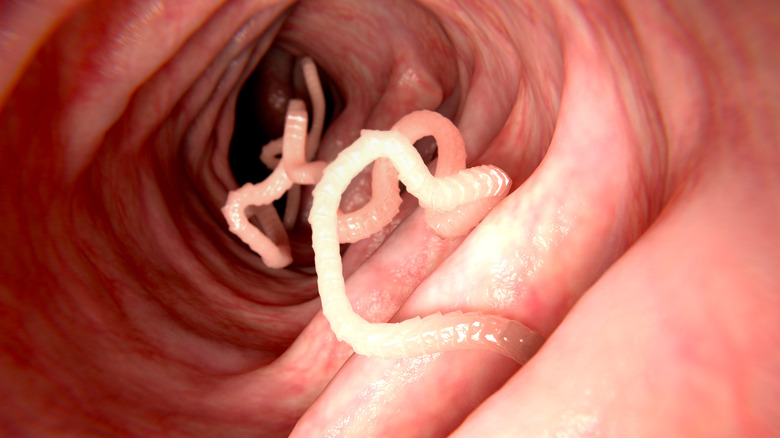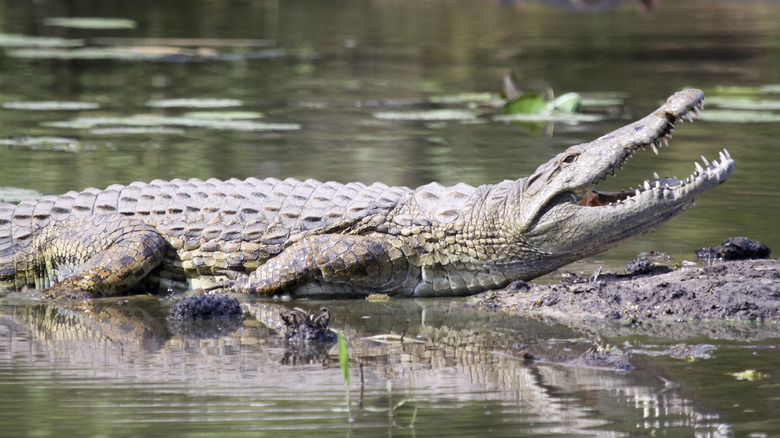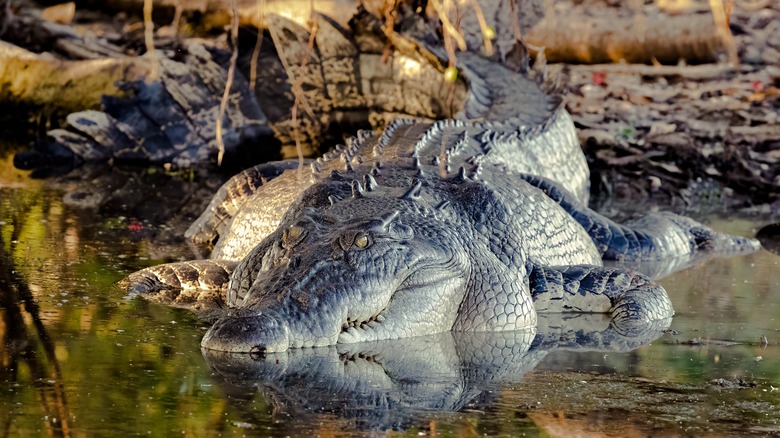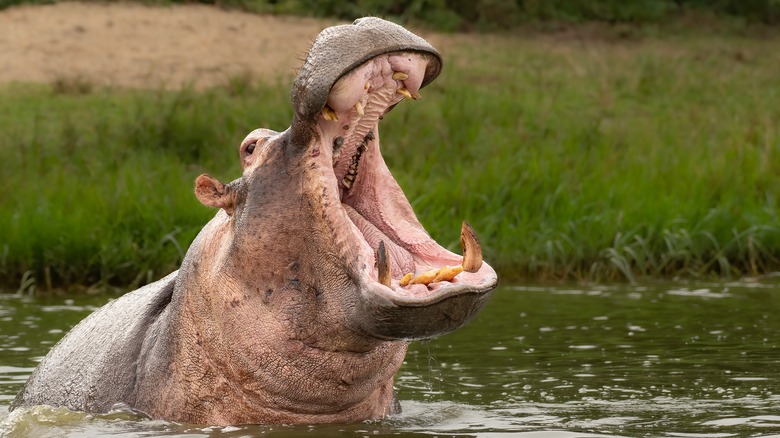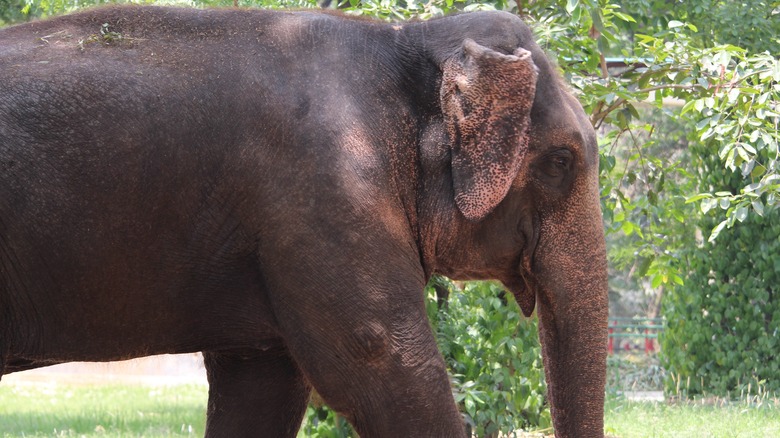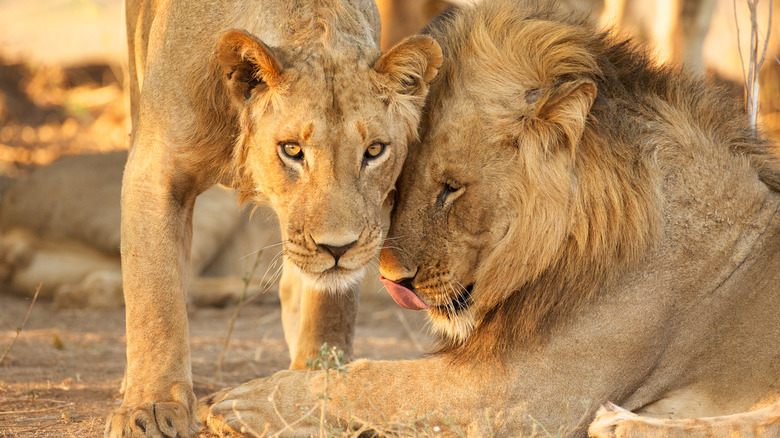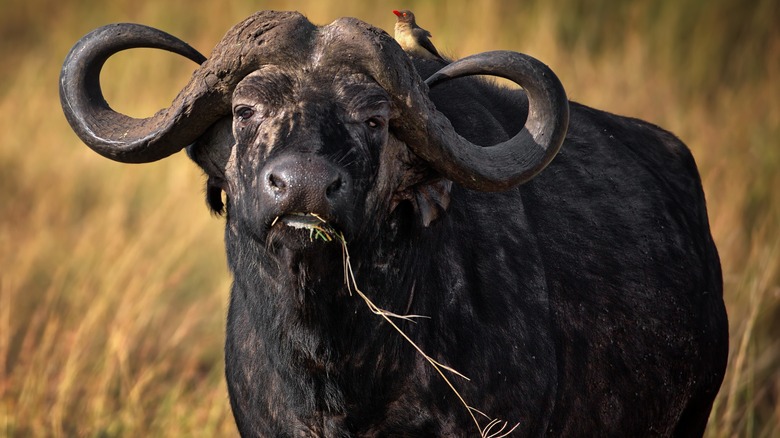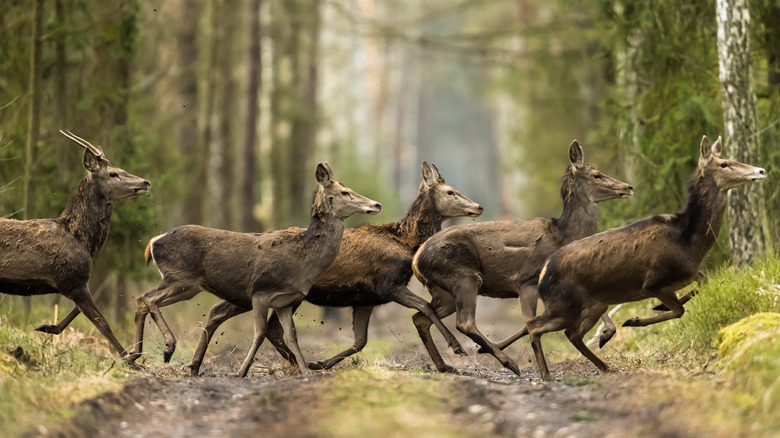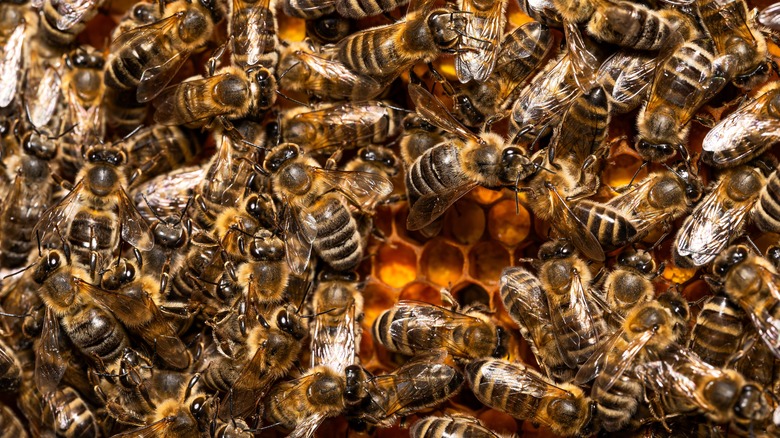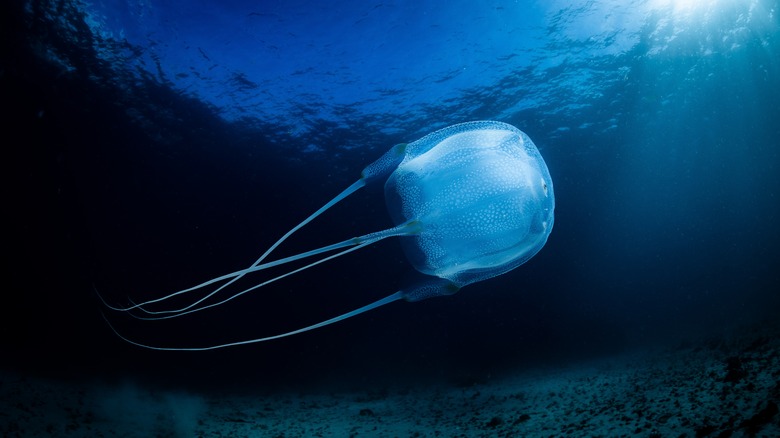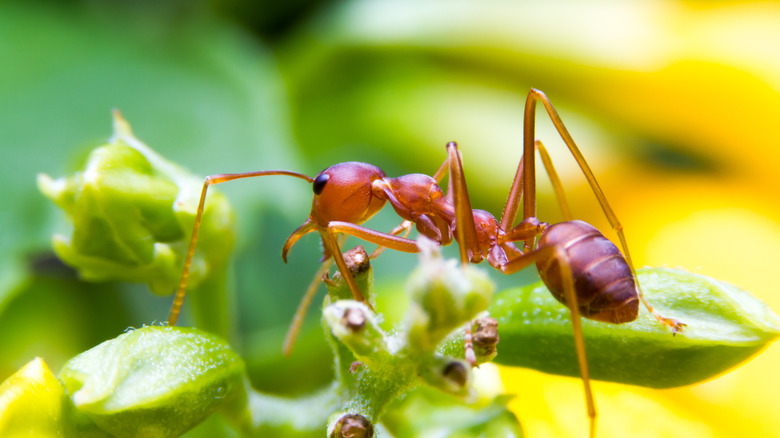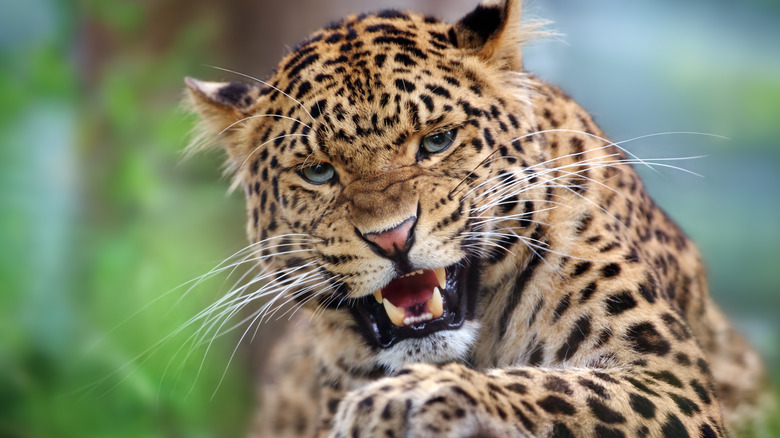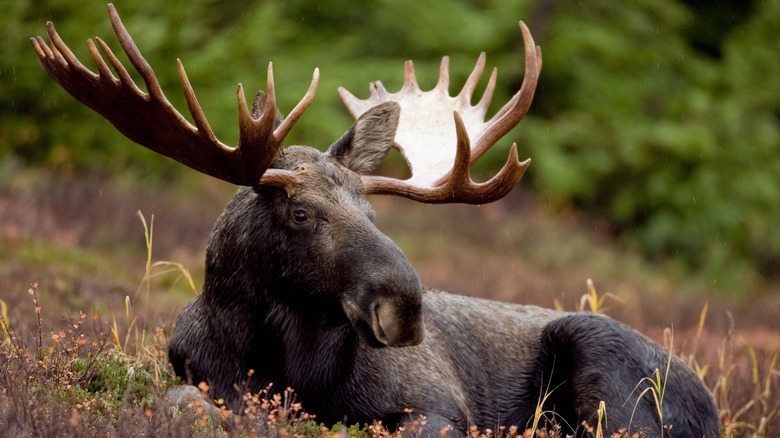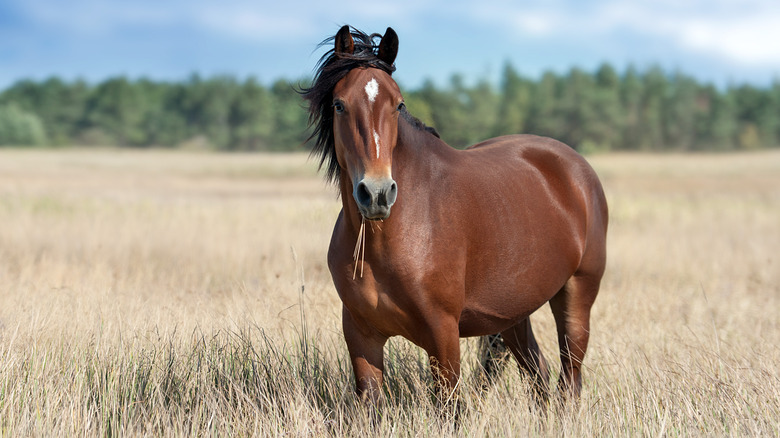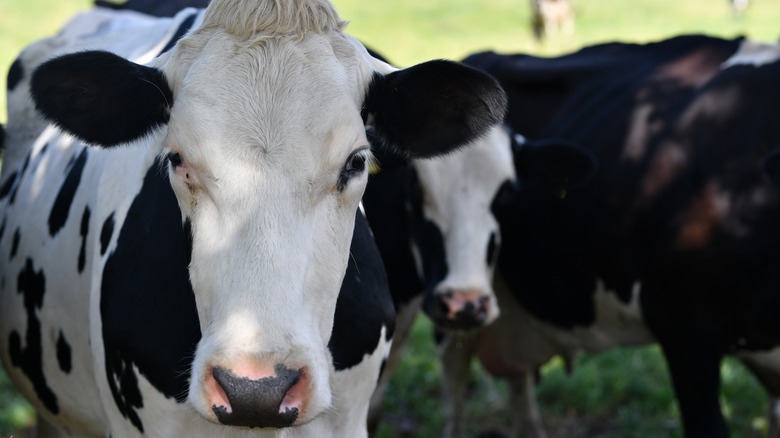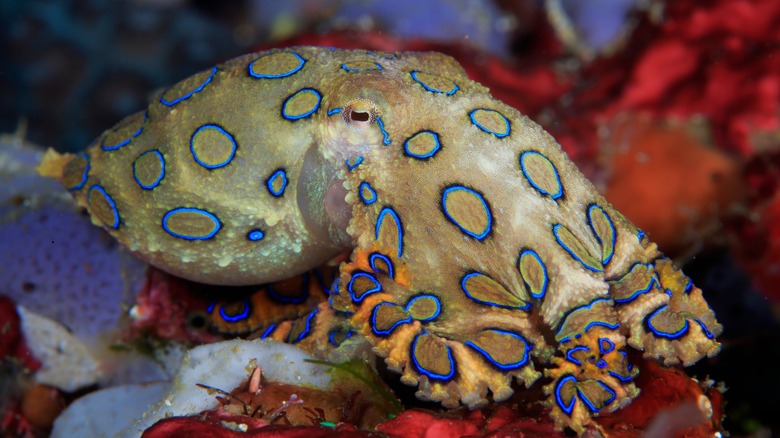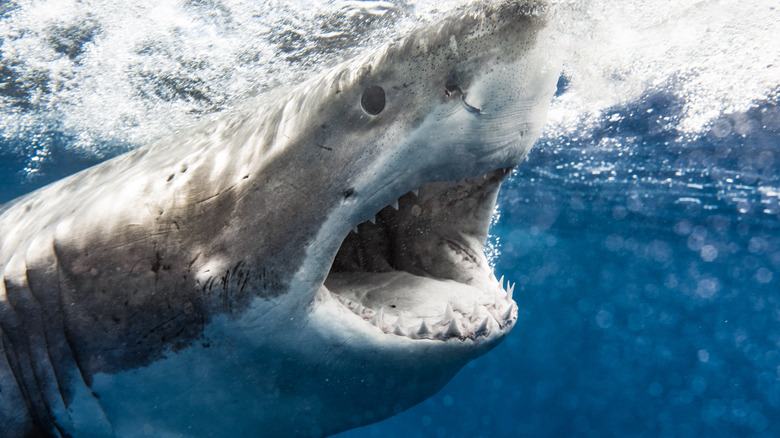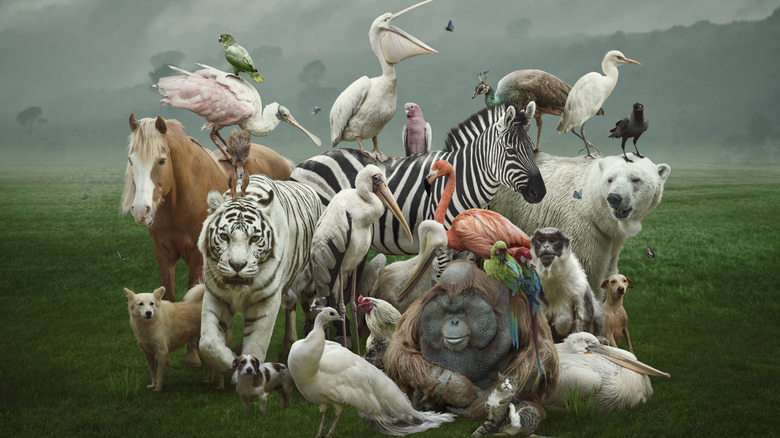The 30 Deadliest Animals In The World
The animal kingdom is full of deadly animals. With an evolutionary dynamic of predator and prey, some animals are simply built to kill, but predators like these are typically adapted to the specific prey animals they eat. And while they're designed to be the most silent stalkers, fastest chasers, hardest biters, and more, most predators aren't really a serious problem to humans these days. This is likely because of our modern technology, the limited numbers of living predators able to take down humans, and other factors that simply keep us out of their paths.
The deadliest animals in the world are actually creatures humans encounter every day in one part of the world or another. These animals take more human lives every year than other members of the animal kingdom. You'll be more likely to encounter some of them, depending on where you live and your future travel plans, but unless these deadly animals are behind glass at a zoo, you won't want to willingly encounter them at all.
Mosquitos – worldwide
The mosquito is certainly a nuisance. They plague you through even the mildest warm months, and their bites cause itching bumps in the most inconvenient locations. Mosquitos are found all over the world, and you'll probably run into the little annoyances when you travel. Unless, of course, you're traveling to one of the coldest cities in the world. But these animals are much more than an irritant. They're actually the world's deadliest animal.
Mosquitos carry a range of dangerous diseases. According to the CDC, mosquitos carrying malaria are most common in Southeast Asia and Africa but can be found in other areas as well. West Nile is pretty widespread at this point and touches multiple areas on every continent besides Antarctica. Dengue can be found primarily in South America and Asia. Yellow Fever is common in tropical areas. The list goes on, so it's best to protect yourself from mosquito bites both abroad and at home.
Humans – worldwide
Humans are truly one of the most dangerous creatures on the planet — especially to other humans. To put this into perspective, humans are responsible for nearly 465,000 murders each year, as noted by the World Population Review. This number jumps even higher when we add in the countless wars that have plagued our species since the dawn of its existence. There's also death by poverty, starvation, and other factors that usually have their roots in greed or improper distribution of resources.
It would be nice to think we're only a danger to ourselves, but that's also not true. Thanks to pollution and overproduction, humans are the driving force behind climate change, which is killing species from all kingdoms. Our hunting and urban spread have also been deadly. Just look at the number of species we've driven into extinction.
The Russell viper – India
The Russell viper lives primarily in Southeast Asia and can be found in particularly high concentrations in India. These animals stick mostly to open spaces and grassy fields, which is exactly why they're such a problem. This viper causes roughly 42,000 deaths each year in India alone, based on a study published in Epidemiology and Global Health that tracked bites from 2000 to 2019.
Due to the amount of farming in India's rural areas, these deadly snakes often come in contact with those working in the fields. There's nothing that suggests the Russell viper is particularly aggressive, but farmers simply share agricultural space with the snake's chosen hunting grounds. If you plan on spending time in India or other parts of Southeast Asia, it's best to avoid fields with tall grass.
The black mamba – Southern and Eastern Africa
Most of us have heard about the black mamba who lives in the southern and eastern areas of the African continent. This snake might not have as many deaths behind its name as other snakes, but due to lack of reporting, we can't be certain what that exact number is. What we do know is that getting bitten by one of the deadliest snakes in the world wouldn't be a pleasant time.
There are roughly 50,000 yearly snakebite deaths in Africa, according to an article in Nature Africa, and though we don't know the number of those caused by the black mamba, it's safe to assume that a high percentage of deaths are caused by black mambas. This snake's venom is especially deadly. Without intervention, those afflicted by the venom die in every case, as PBS notes. If you spot these snakes during a safari to Africa's savannahs, it's best to avoid them, as they can be extremely aggressive.
The common krait – India
Other deadly Indian snakes are found in rural areas, but the common krait does much of its killing inside human living quarters. It's fairly common for people to sleep on the floor in these rural Indian areas, and these snakes may be drawn into bedding since the warmth humans emit can heat their cold blood.
Unfortunately, around 10,000 people in India die from krait bites each year, according to an article in Epidemiology and Global Health. The Handbook of Clinical Neurology says that roughly 50% of people bitten in rural settings die if bitten at night, which is usually when this snake attacks. There is an antivenom for krait bites, but limited access to medical facilities makes this bite dangerous. If you plan on visiting India or other parts of Southern Asia, you'll want snakeproof living quarters.
The Indian cobra – India
You'll notice that quite a few deadly snakes have made this list. Since there are quite a few venomous varieties, it's not too surprising that they happen to kill more humans than any other reptile. The next one on our list is the Indian cobra. Yes, the cobra makes the list with roughly 7,500 deaths in India alone. Other countries within the Indian subcontinent only add to this kill count.
The Indian cobra isn't particularly aggressive. They, like other snakes, can become aggressive if threatened or cornered. You're most likely to encounter these snakes in rural areas, and they become the most dangerous in places you can't see. Think of stepping on an Indian cobra while hiking through the grass. If you find yourself in areas where this snake lives, you'll want to avoid going off-trail.
Saw-scaled viper – Africa and Asia
Saw-scaled vipers aren't a single species but rather an entire genus of vipers that can be found from northern Africa through southern Asia. There are eight species total in this genus, and they're responsible for more deadly snakebites than any other snake on the planet. That includes the others on this list, but since they're a collective, we put them lower on the list.
These snakes are small, thick creatures with an incredibly deadly bite. They're likely to be spotted after dusk since they're nocturnal, and they're not the biggest fans of humans. Unlike the majority of other snakes, saw-scaled vipers have a naturally aggressive temperament, but they also have a warning bell. So, if you hear hissing, watch your step.
Dogs – worldwide
Dogs may be man's best friend, but they're also one of the deadliest animals on the planet. Sure, the wild members of the canine family are more viscous predators than their domesticated counterparts, but it's not the canine's bite that makes it so dangerous. It's what that bite carries.
Research published in Forensic Science International suggests that dog attacks in the Western world account for fewer than 100 deaths, so it would be safe to say dog attack fatalities are fairly low worldwide. Dog bites, on the other hand, are much more common, and these dog bites are the top vector for rabies transfer. In fact, the CDC says that 99% of the roughly 59,000 human rabies deaths each year occur because of dog bites.
Tsetse flies – sub-Saharan Africa
Tsetse flies are certainly the deadliest of all flies. While not venomous or toxic, they carry a creature that makes life unpleasant for thousands of people in sub-Saharan Africa, a protozoa known as Trypanosoma. This microscopic organism is responsible for "African sleeping sickness" and roughly 50,000 deaths every year, as a research paper in The Journal of Clinical Investigation explains. That's a death rate of about 1 in 20 people who contract the disease, and the two primary strains of the disease kill between months and years.
The CDC warns that travelers can contract this disease if visiting sub-Saharan Africa, especially in game parks and if spending a lot of time outside. So, it's best to take preventative measures against tsetse bites, such as wearing neutral-colored clothing that covers your whole body.
Assassin bugs – The Americas
Assassin bugs, also called kissing bugs, earn their name by brutally killing their prey with a sharp protruding beak. It gets its "kissing bug" name from biting humans around their mouths. It gets a terrible reputation because, as the CDC explains, it kills nearly 10,000 people every year, but it doesn't do it alone.
Like the tsetse fly in Africa, the assassin bug spreads a Trypanosoma through the United States, Central America, and South America. In the U.S., you'll mostly find them in the warmer climates of the South. The Trypanosoma spread by the assassin bug causes Chagas disease, and it's believed that 7 million people in its range carry this disease. There are treatments for Chagas, so if you're ever bitten by an assassin bug, you'll want to talk to your doctor quickly.
Freshwater snails and trematode worms – worldwide
While it may sound crazy, freshwater snails are one of the deadliest animals on Earth. Well, it's more of the partnership between the freshwater snail and trematode worms that cause problems. It's that tandem effort that causes so many deaths. According to the World Health Organization, trematode infestations claim the lives of nearly 12,000 people around the globe.
The geographic location of trematodes spreading by freshwater snails is broad and includes Africa, the Middle East, and several locations in Asia and South America. Since the worm and its transmitting snail are primarily found in natural freshwater sources, such as streams and ponds, you should avoid swimming or drinking from natural bodies of water where the snails are common. Trematode worms enter through the skin, so DEET insect repellents can also help ward them off.
Scorpions – worldwide
Scorpions are certainly a scary animal. They have pinching claws and venomous stingers on their tails. That being said, they don't claim as many lives as you may think, but they still kill more than spiders, which you'll notice haven't even made this list. In the world of arachnids, scorpions are the deadliest.
As a journal in the Public Library of Science notes, there are over 1 million scorpion stings every year across the globe, but only 3,250 die from those stings. These stinging creepy crawlies can be found in almost every desert and tropical area of the world, but some live as far north as Canada and central Europe. Most of them aren't deadly to humans, though. For example, the bark scorpion is the only scorpion that may be fatal in the United States.
Ascaris roundworms – China
The Ascaris roundworm causes more infections worldwide than any other roundworm. Though the highest concentrations of this parasite seem to be throughout eastern Asia, this parasite can be found in sub-Saharan Africa, Latin America, the Caribbean, the United States, and tropical places around the world. And Ascaris roundworms can certainly be deadly.
The annual death toll for the Ascaris roundworm is difficult to pin down. Some sources place it in the tens of thousands, while others estimate deaths at around 10,000 people per year. Regardless, even the lower estimates place the Ascaris roundworm among the deadliest animals. According to the CDC, victims are infected by Ascaris roundworm eggs when eating with unwashed hands or consuming vegetation from infected dirt. So, when you're traveling, be sure to wash your hands and vegetables.
Tapeworms – worldwide
The tapeworm is a parasite we're all familiar with. It's a long, intestinal parasite that hides in human digestive tracts, feeding off the meals we ingest. It's creepy and gross to most of us, but few of us think of tapeworms as deadly. It definitely is. As the Texas Department of Health and Human Services notes, roughly 50,000 people die from tapeworm-related issues every year.
Tapeworms live wherever cattle and pork are raised. They're passed primarily through ingesting undercooked meats infected with the critter or its eggs, but they can be passed from person to person. This parasite can form two different types of infections. The adult worms can hang out in the digestive tract, and newly hatched larvae burrow their way into our bloodstream. From there, they can form cysts in any part of the body. The only way to protect yourself is to eat properly cooked meats and follow proper handwashing procedures.
The Nile crocodile – sub-Saharan Africa
The Nile crocodile lives almost exclusively in sub-Saharan Africa, but the waterways it often occupies are close to villages, which is why the Nile crocodile kills around 200 people each year, according to National Geographic. Those numbers look low, but compared to widespread infections and infestations, traditional fatal animal attacks are comparatively rare.
The Nile croc is one of the larger crocodiles, weighing in at around 500 pounds, though they can reach over 1,500 pounds. And since these animals are known to hunt any creature that comes to the water's edge, we're on the menu. It's important to be cautious while visiting the Nile or other bodies of water since these are ambush predators. That means if you're not paying attention, you might not see a Nile crocodile before it attacks.
Saltwater crocodile – Southeast Asia and Australia
Nile crocodiles might be more dangerous, but saltwater crocodiles are certainly bigger. These bad boys can weigh over 2,000 pounds. The crocodiles in the United States that live in saltwater are American crocodiles. This saltwater croc makes its home along the southeast Asian coasts, but because they can swim great distances of ocean, they can also be found in Australia.
Though these animals are estimated to have fewer kills than Niles, they're considered the world's most aggressive, so it's best to stay out of their way altogether. Reports on saltwater crocodile attacks don't seem to list a solid number, but Statista indicates around 1,000 fatalities due to all species of crocodile. With its aggressive nature and massive size, saltwater crocodiles are probably to blame for many of these deaths.
The hippopotamus – sub-Sahara Africa
Hippopotamuses appear to be big, lovable water cows that want hugs. Do not hug them. The hippopotamus is actually one of the most aggressive and territorial animals in all of Africa, following only the crocodile for the number of humans it kills each year. Like with most animals, hippos don't go out of their way to attack people. Instead, they have a territorial bubble (a pretty big bubble), and if you get too close, they'll charge. No wonder they manage to kill around 500 each year (via USA Today).
When dealing with hippos, it's probably best to stay away from them. Unless you're at the zoo or on a safari, that's pretty easy to do. But if you happen to be touring Africa on safari or taking bush tours, listen to your tour guide, and never try to pet an adorable baby hippo.
Elephants – Africa and Southern Asia
Elephants are generally considered to be one of the smartest animals on land. They're also one of the largest. And, to the surprise of many, they're one of the deadliest animals in the world. According to the International Fund for Animal Welfare, elephants kill more than 400 people every year. Most of these killings are committed by the Indian elephant. The African elephant is typically responsible for less than ten killings each year.
Either way, these massive animals can become aggressive when cornered. They've even been known to destroy homes. Add in the tusks and a whole lot of anger, and the elephant becomes one animal you don't want to mess with. You probably won't have to worry about being attacked by elephants unless you get way too close. That includes both African and Indian elephants.
Lions – Africa
Giant cats have been killing humans since before our ancestors branched out of Africa, so it's not entirely surprising that one of the largest of the big cats makes this list. Lions are pack hunters who can take down the largest game in the African savannas and around 250 people per year, according to Statista.
Tanzania has the largest lion population of any country in the world, and, as a research paper in Nature points out, around 560 people were killed by lions in the country between 1990 and 2005. Also, according to NBC News, the number of lion attacks has been on the rise since the mid-2000s. It's not too difficult to stay safe from lion attacks. Just follow the rules when touring the open savanna.
The Cape buffalo – sub-Saharan grasslands
When we think of a list of deadly animals, we don't envision herbivores, especially ones like the Cape buffalo that are no bigger than a cow. These animals stick to the sub-Saharan grasslands of Africa, and they don't usually cause any trouble. That being said, they still have an annual kill count of around 200 people, as noted in the Independent.
These bovids travel in herds ranging from a few hundred members to over 1,000. They're large animals, and they have a pretty impressive rack of horns on top of their heads. A threatened, charging bull can easily kill a person, as buffalo hunters who've been gored by their horns have learned the hard way. Remaining protected from the Cape buffalo is pretty easy. Don't get too close to the herd.
Deer – worldwide except in Australia and Antarctica
Deer can be found in nearly every corner of the world, excluding Australia and Antarctica. Deer contribute to human deaths primarily through motor vehicle accidents. The United States is plastered with deer crossing signs meant to keep drivers alert to this threat. Deer in other parts of the world also step onto highways in front of speeding cars, contributing to over 400 deaths every year, the National Park Service reports.
Now, that number is shared with other similar species, such as elk and moose, but when we look at the stats from Statista, deer account for at least 100 deaths each year. If you want to stay safe from these kinds of potential fatal encounters, it's best to know your area, drive with caution, and stay alert at the wheel.
Bees – worldwide
The world needs bees. They're the primary pollinator on the planet, and without them, humans would have a difficult time surviving. But not everything about bees is great. For some, bee stings can be deadly. A single sting can send someone into anaphylactic shock, which can result in death. It's estimated, according to The Conversation, that roughly 2 million people in the United States suffer from this allergy, with slightly below 100 deaths per year (via the CDC). That number goes way up when we look at other countries.
If you think you need an allergy to die from bee stings, you're wrong. It's much harder for bees to kill someone without it, but it can happen, especially to the really young and really old. It takes over 1,000 stings, on average, to be deadly, but since bees often live in large hives, that's not outside of the realm of possibilities.
Box jellyfish – worldwide
Anyone who has spent time in the ocean knows that jellyfish can be dangerous. Their tentacles carry stingers that, in most cases, inject painful toxins. Unfortunately, some jellyfish can do more than cause pain. The box jellyfish, for instance, can kill. Though the box jellyfish typically chills in tropical waters, it can float to anywhere in the seven seas.
Usually, large populations of jellyfish are tracked and warnings are provided at beaches when they congregate. That being said, you wouldn't want to mistakenly run into a swarm of these jellyfish. They kill up to 40 people every year, as Science explains, making it the deadliest jellyfish on the planet. Some researchers believe the number of box jellyfish deaths is much higher but underreported. For instance, some believe the Philippines experiences close to 500 deaths every year. Be careful where you swim and listen to local swim warnings.
Ants – worldwide
Ants span the globe, minus Antarctica, and live in large colonies. Some species of ants have venomous stings or bites that can be excruciating, such as the bullet ant in South America, but other ants can be deadly. For example, the Asian needle ant has a sting capable of causing allergic reactions on the same scale as bee stings. This ant is spread across the Asian continent and has recently been found in several states across the U.S. East Coast.
The fire ant, according to KPNX News, kills around 30 people every year in the United States. The jack jumper in Australia also has enough venom to kill. The list goes on. To protect yourself from deadly ants, it's best to avoid areas where they hang out and report any ant bites or stings to healthcare professionals. Outside of that, DEET has shown promising results for warding off ants like fire ants.
Leopards – Africa and Asia
Leopards are smaller members of the big cat family, but that doesn't mean they're to be messed with. These predators have massive teeth and claws. Not to mention the grace, silent prowl, and agility of a cat. That alone makes them dangerous to unsuspecting humans, but the number of kills certainly adds to it.
You can find these big cats throughout Africa and much of central Asia, and even with dwindling numbers on the Asian continent, leopards have still managed to kill humans in India. According to the Independent, a combined number of 34 people were killed by leopards and lions in a single Indian state in 2023. During three months of the same year, seven people were killed in another Indian district, as BBC notes. Leopards are more prone to attack children, so the best thing you can do is to keep your children near you while in leopard country.
The Moose – North America, Europe, and Russia
Moose can be found up north, and their range spans North America, Europe, and Russia. Moose are big animals that can grow well over 1,000 pounds, and though they're not aggressive by nature, they can become so if provoked. In fact, they injure more people than bears, according to the Alaska Department of Fish and Game. But that's only part of the danger with moose.
Humans have the same issue with moose as they do with deer. These animals contribute to motor vehicle fatalities annually, and though it's difficult to separate which of the 440 yearly deaths go to which animal, it's clear that moose are responsible for some of them. So, basically, protecting yourself from moose comes down to leaving them alone and driving safely. Not too difficult.
Horses – worldwide
Almost all horses are domestic, and many have a friendly temperament. That being said, horses can be dangerous. They don't attack humans outright like other animals on this list, but the danger with horses tends to come with how humans use them.
According to Britannica, horses kill around 100 people every year in the U.S. The Brain Injury Association of Missouri says 1 out of every 10,000 horse riders dies yearly, with over 700 deaths and 100,000 total injuries. Horses buck and people fall out of saddles, and if we take into account the occasional farrier that gets kicked by those powerful legs while trimming hooves and tacking shoes, this number might be even higher. Regardless, if you're trained and experienced, it can help mitigate accidents.
Cows – worldwide
Have you even heard that you're more likely to be killed by a cow than a shark? Well, it's true. Cows also kill more than any one species of venomous spider. For one, people come into contact with cows often, and these creatures are bred to be big and muscular. They're pasture powerhouses, and they're plenty capable of taking down a human. Luckily, outside of the angry bull and the Spanish tradition of running with them, cows don't typically attack humans.
As Discovery explains, cows kill roughly 22 people each year in the United States, which is a lot for such a cute animal. On at least five different occasions, according to the World Animal Foundation, groups of cows have been seen ganging up on and killing a single person. If you're not a professional, you might want to stay out of the cow pasture.
The blue-ringed octopus – Western Pacific
Octopus are some of the coolest creatures on the planet. Some are capable of mimicking other animals, they're smart, and they can collapse themselves to fit into tiny spaces. However, the blue-ringed octopus, which lives in the Pacific Ocean between Japan and Australia, is deadly venomous.
Although cute, these small, eight-legged animals don't want to be messed with. Since the ones in shallow water are typically small, people think they're okay to hold. The truth is that their venom is extremely toxic and has no known antidote, making it a guaranteed death sentence unless immediate medical intervention is sought out. And while they haven't killed many, their venom is astounding. The blue rings on these octopuses only appear when they feel threatened, so use them as a warning sign.
Sharks – worldwide
For being such a feared animal, the shark makes the bottom of the list of deadliest animals. Some sharks can be monstrous, like the great white which can reach more than 7,000 pounds, and some are much smaller. They also have deadly rows of razor-sharp teeth and can be found in every ocean on Earth. But sharks really don't bite humans very often, let alone kill them.
According to the International Shark Attack File, there were only 10 shark-related deaths worldwide in 2023, and this number is pretty average. Humans aren't natural prey for sharks, and they certainly don't seek us out as food. When spending time in shark-infested waters, it's important to be aware and keep your distance, but it's impossible to go into the ocean without being in a shark's territory.
Methodology
For the most part, the way we decided which animals were the deadliest animals in the world was simple: kill counts. There are animals out there more capable of being deadly, but since they don't often attack humans, we didn't add them. A few of the animals on the list also rarely attack humans, but there's a reason those were selected. These special exceptions are so venomous that humans have almost no chance of surviving a bite or sting without immediate intervention.
